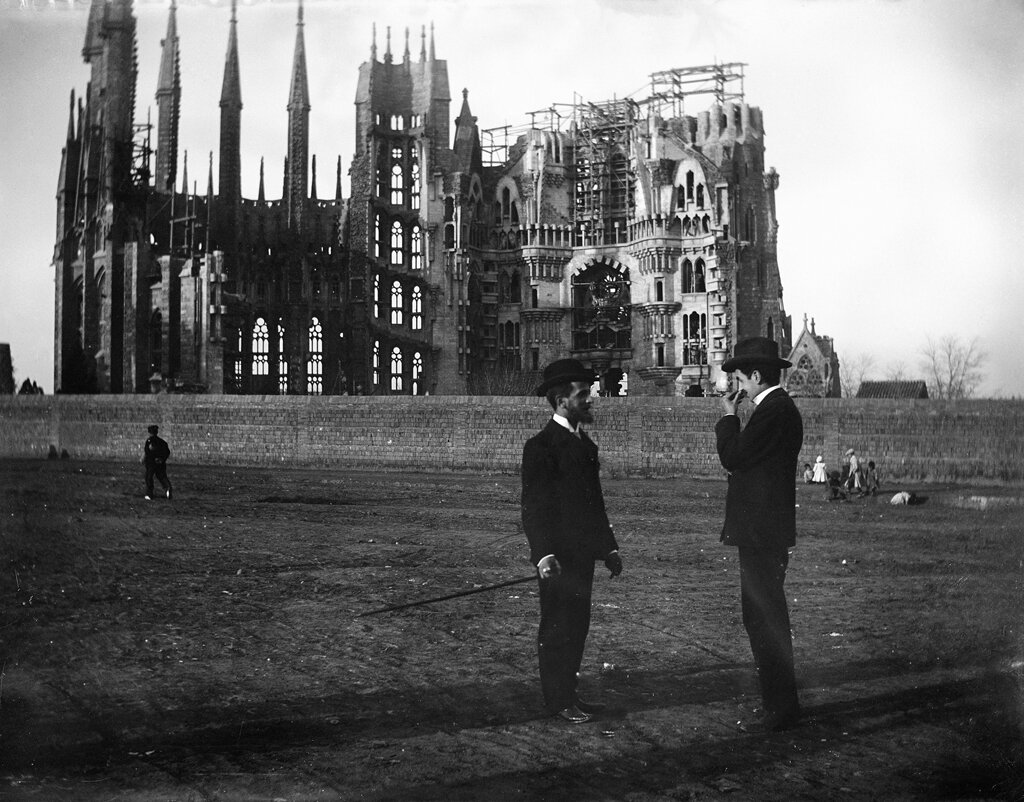Modelmaking Throughout History: Sagrada Família
The Sagrada Família in 2012.
The distinctive silhouette of the Sagrada Família basilica in Barcelona has been polarizing opinions for over 130 years. Louis Sullivan, the father of skyscrapers, called it “greatest piece of creative architecture in the last twenty-five years” (1), whereas George Orwell called it "one of the most hideous buildings in the world" (2).
One of the unique aspects of this building is that its construction is primarily based not off plans or elevations, but reproductions and fragments of plaster models that were created by its designer over a century ago (3).
The Sagrada Família under construction in 1905.
Architect Antoni Gaudí certainly had an affinity for physically modelling his architecture rather than drawing it. He was at the time already recognized for his unique way of studying the strength of particular masonry techniques, by using chains or weighted strings suspended from the ceiling. For example, he discovered that the inverse shape of the curve achieved upside down in a weighted chain would correlate precisely with the strongest curve of an archway made from stone. The benefit of using chains for this purpose is that when you move one end of the chain, the entire length adjusts itself automatically into the most stable and balanced position. This is a kind of ‘analogue parametric’ modelling that he would employ to great success throughout his career (4).
Gaudí's catenary model at Casa Milà.
When Gaudí assumed responsibility for the design of the building in 1883, he spent a lot of time making intricate models out of plaster in order to convey a clear vision of his design to subsequent generations of builders. Creating construction drawings of his unique naturalistic designs would have been nearly impossible both to draw by hand and for the builders to follow. Look at the extremely intricate detailing in the image below to see what we mean.
Exterior façade.
Gaudí used the model as a design tool, refining the design over time by drawing inspiration from organic forms, which he emulated and incorporated into his work (3). He used many iterations of models to visualise volume and shape, built in scales of 1:10 and 1:25 depending on whether the goal was to study the building mass or to view particular details for construction (5).
In 1936, during the Spanish civil war, the partially constructed building was set on fire and the workshop was vandalised. This destroyed some of Gaudí’s original plans, drawings and plaster models, leading to a 16 year process of painstakingly piecing together the remaining fragments of Gaudí’s master model (6).
Construction of the Sagrada Família is still ongoing (well, it was until March 2020 when it was halted for the first time since the Spanish Civil War due to the COVID-19 pandemic (7)), and the tradition of using models to aid in its creation has also continued.
The head of the modern modelmakers workshop, Albert Portolés, explains that from the old models that have been restored and preserved, they have studied Gaudí and come to understand what he wanted to create and how he wanted to do it. He uses the model of the sacristy as an example. Gaudí’s original idea was to create a central elevated space full of light inside the building; a lantern. It was only by restoring Gaudí’s plaster model of the sacristy that the geometry of this space could finally be understood and actually built (5).
The modelmaking workshop of the Sagrada Família. © José Luiz Bernardes Ribeiro / CC BY-SA 3.0
With newer technologies such as 3D printing, the modelmaking team is now able to work at much smaller scales than were ever possible to Gaudí, including 1:100, 1:200 and 1:400. When working at larger scales however, they still prefer to make models by hand, either by making moulds or by creating surfaces directly in the plaster.
When asked about the advantages of working with physical models, Portolés explains that the models are first visual, and then tactile. You can pick them up, touch them, handle them. You see how the light interacts with the surfaces, how the element interacts with its surroundings. He says that while a render gives an approximation, a model lets you see it in reality. On a personal note, he adds that it is a very fulfilling challenge, bringing the dream of a genius to life (5).
(1) Mower, David, Gaudí, Oresko Books Limited, 1977.
(2) Orwell, George, Homage to Catalonia. Secker and Warburg, 1938.
(3) Congdon, Roark T. Architectural Model Building: Tools, Techniques and Materials. Fairchild Books, 2010.
(4) Gomez-Moriana, Rafael, “Gaudí’s hanging chain models: parametric design avant la lettre?” Criticalista. Accessed June 6, 2020. https://criticalista.com/2012/08/16/gaudis-hanging-chain-models-parametric-design-avant-la-lettre/
(5) “Model makers, essential for testing and correcting.” YouTube. Video File. Accessed June 6, 2020. https://youtu.be/R1Dydnru1c0
(6) Fraser, Giles. “Barcelona's Sagrada Família: Gaudí's 'cathedral for the poor' – a history of cities in 50 buildings, day 49.” The Guardian, June 3, 2015, Accessed June 6, 2020. https://www.theguardian.com/cities/2015/jun/03/barcelona-sagrada-familia-gaudi-history-cities-cathedral-poor-church-religion
(7) Kouimtsidis, Dimitris. “Spain’s La Sagrada Familia Will Not Restart Construction Works Until After Visitors Return.” The Olive Press, May 4, 2020, Accessed June 6, 2020. https://www.theolivepress.es/spain-news/2020/05/04/spains-la-sagrada-familia-will-not-restart-construction-works-until-after-visitors-return/





